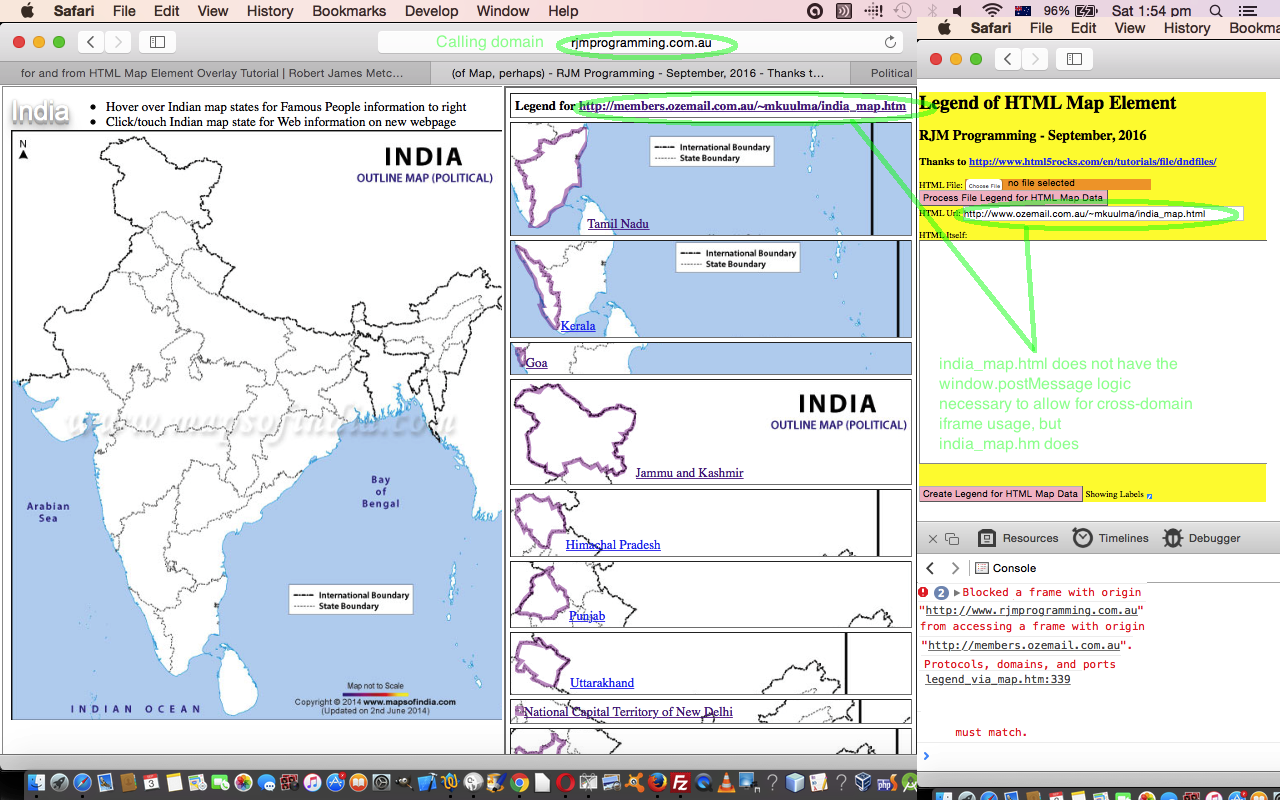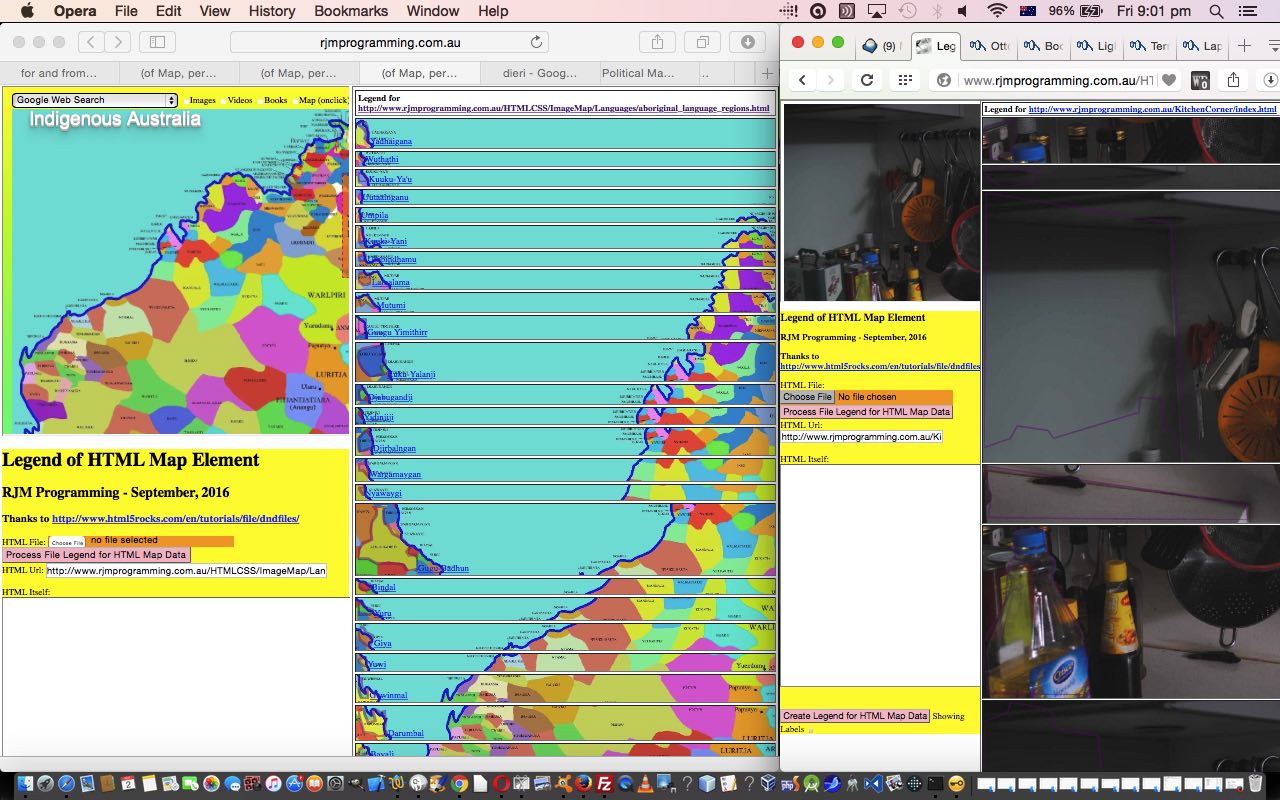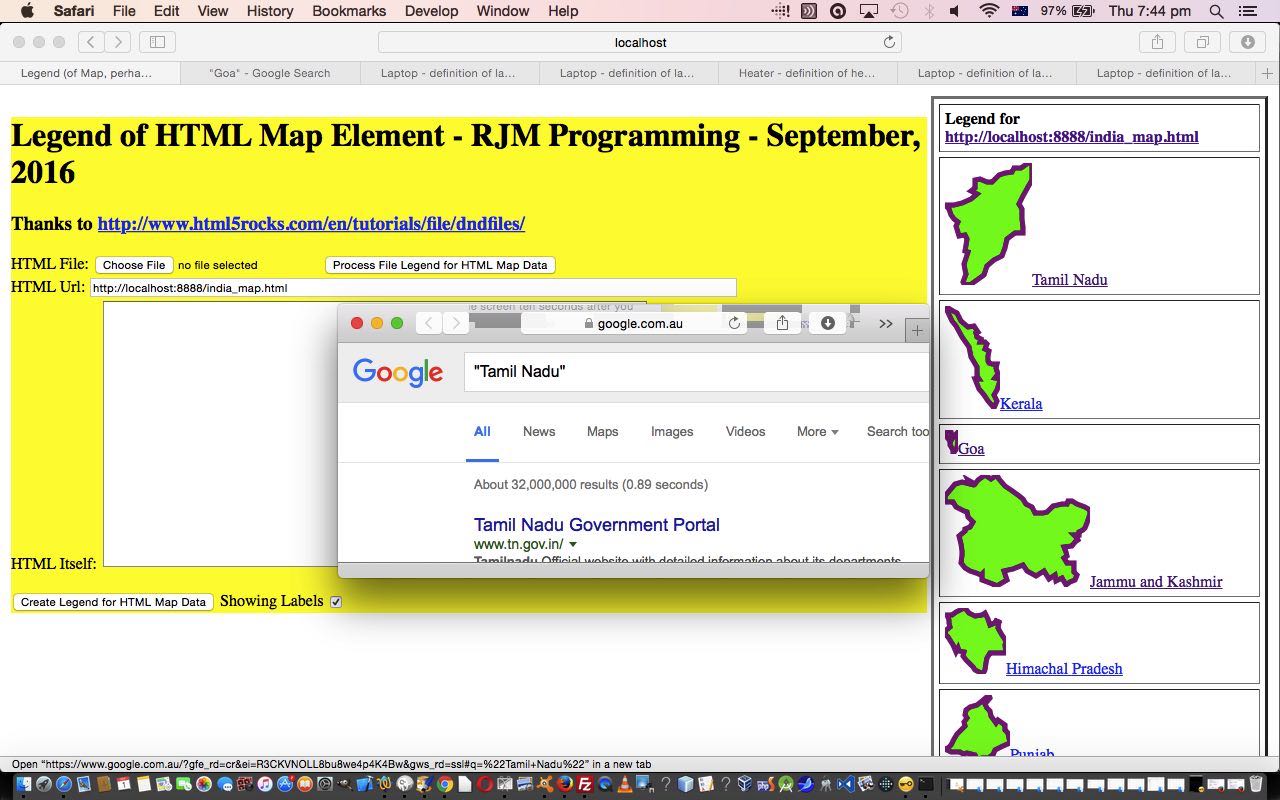We’re talking about cross-domain issues today, and the wonderful window.postMessage messaging method to talk between parent HTML windows and child HTML iframe windows that aren’t on the same domain. But before you get too excited, it takes co-operation on both sides to make this happen … perhaps, Curb Your Enthusiasm … finished … good … because this is pretty suave.
So within the “HTML Url” input section workings of our latest “Legend of HTML Map Element” thread of blog posting web applications, after that last Legend for and from HTML Map Element Overlay Tutorial one, we now have the scenarios …
- Urls of domain “http://www.rjmprogramming.com.au” … which function in all aspects sending and reading the details of the HTML map element via an HTML iframe element … and …
- Urls of local web server, in our case a MAMP one via “http://localhost:8888” ones … which function in all aspects sending and reading the details of the HTML map element via an HTML iframe element … and …
- Urls of domain “http://members.ozemail.com.au” (with Url containing “/~mkuulma/”) … which (used not to, but now) function, via the individualized code changes we talk about below, in all aspects sending and reading the details of the HTML map element via an HTML iframe element, and making use of “windows.postMessage” logic … and …
- Other Urls … that the best we can do, so far, with our blog post threads, is to open via “window.open” popup window, but not be able to extract the HTML map element, in order to be able to create a Legend on the right hand side … more on this one into the future
Today we’re concentrating on that third one and have had great help from that previous link and this other link … thanks … to construct working cross-domain child iframe examples of …
- Indigenous Australia Language Map … or below
- India State Map
- ESL Vocabulary – Living Room
- ESL Vocabulary – Kitchen Corner
… as distinct from another web application without the cross-domain iframe to use window.postMessage logic, as for …
- ESL Vocabulary – Living Room Corner … that does work not as an iframe child
Stop Press
As of recently the left link above will probably work, but it remains the case that its coding has not had any window.postMessage logic added to it. We’ll be explaining this with tomorrow’s tutorial.
… luckily for internet users worried about security breaches that can happen if care is not applied with this functionality.
So, below, is the Javascript code applied, the same, for each of the child HTML iframe web applications as above …
<script type='text/javascript'>
// Thanks to https://developer.mozilla.org/en-US/docs/Web/API/Window/postMessage with code below ...
// Called sometime after postMessage is called
function receiveMessage(event) {
// Do we trust the sender of this message?
if (event.origin !== "http://www.rjmprogramming.com.au") {
return;
}
if (document.URL.indexOf("/~mkuulma/") != -1) {
if (event.source == window.opener) {
if (event.data == "hello there!") {
// Assuming you've verified the origin of the received message (which
// you must do in any case), a convenient idiom for replying to a
// message is to call postMessage on event.source and provide
// event.origin as the targetOrigin.
event.source.postMessage(document.body.innerHTML + " Hello RJM Programming! the secret response " +
"is: av-a" + "-car-do!",
event.origin);
}
}
}
}
if (window.addEventListener) {
window.addEventListener("message", receiveMessage, false);
} else if (window.attachEvent) {
window.attachEvent("onmessage", receiveMessage);
}
</script>
… and in the parent HTML Javascript code …
<script type='text/javascript'>
var popup=null, rawurl;
function receiveMessage(event) {
// Do we trust the sender of this message? (might be
// different from what we originally opened, for example).
if (event.origin !== "http://members.ozemail.com.au") {
return;
}
// event.source is popup
// event.data is document.body.innerHTML + " Hello RJM Programming! the secret response is: av" + "-a-car-do!"
if (event.source == popup) {
if (event.data.indexOf('av-a-' + 'car-do!') != -1) {
rawhtml=event.data.split('</html>')[0] + '</html>';
checkins();
}
}
}
function crossdomainiframe() {
var thisurl=xrawurl;
if (popup) {
// When the popup has fully loaded, if not blocked by a popup blocker:
// This does nothing, assuming the window hasn't changed its location.
popup.postMessage("The user is 'admin' and the password is 'av-a-c" + "ar-do!'",
"http://members.ozemail.com.au");
// This will successfully queue a message to be sent to the popup, assuming
// the window hasn't changed its location.
popup.postMessage("hello there!", "http://members.ozemail.com.au");
if (window.addEventListener) {
window.addEventListener("message", receiveMessage, false);
} else if (window.attachEvent) {
window.attachEvent("onmessage", receiveMessage);
}
} else {
setTimeout(crossdomainiframe, 2000);
}
}
function check_if(iois) {
if (iois != null) {
var aconto = (iois.contentWindow || iois.contentDocument);
if (aconto != null) {
if (rawurl.indexOf('rjmprogramming.com.au') == -1) {
popup=aconto;
crossdomainiframe();
} else {
if (aconto.document) { aconto = aconto.document; }
if (aconto.body != null) {
rawhtml=aconto.body.innerHTML;
checkins();
}
}
}
}
}
</script>
… and so we come to today’s HTML and Javascript web application legend_via_map.htm that changed in this way and you can try it out with this live run link. We hope you find this cross-domain information interesting.
Previous relevant Legend for and from HTML Map Element Overlay Tutorial is shown below.
We’re continuing on from Legend for and from HTML Map Element Primer Tutorial as shown below, today, putting our Legend into context with respect to the underlying HTML map element’s contents, honing in on the “for” of today’s blog posting title, as distinct from that previous tutorial’s concentration on the “from”. This is our second draft, but I’d be surprised if it’s our last, as it needs more work and functionality, perhaps.
These changes to the HTML and Javascript code today involved “overlay” principles and the use of background images and their positioning with Javascript DOM dynamic CSS “background-position” settings being made to the upcoming Legend elements, on the fly.
Two of the usual “overlay” CSS suspects coming into play were …
- position:absolute property
- z-index
- opacity
We’ve called today’s HTML and Javascript web application legend_via_map.htm that changed in this way and you can try it out with this live run link.
We’ve collected second draft “cakes” of just clientside HTML and Javascript usage, and channeling that great HTML5 Rocks information from this great link, below …
- Indigenous Australia Language Map … or below
- India State Map
- ESL Vocabulary – Living Room
- ESL Vocabulary – Kitchen Corner
Previous relevant Legend for and from HTML Map Element Primer Tutorial is shown below.
Have you ever noticed the synergies between the HTML map element and the HTML table element? What would happen if we, in broad brush terms …
- change “map” to “table” … and …
- change “area” to “tr-td-a-svg–polygon” (“/area” to “/polygon-/svg-/a-/td-/tr”)
? Well, we think we’d be close to getting a “legend” of a map or some other type of data, perhaps.
So we have started down the road towards this idea with our first draft of just clientside HTML and Javascript, and channeling that great HTML5 Rocks information from this great link, thanks, to allow you to “Browse” (button) for local HTML files, as well as the ability to browse an HTML url or just feed in the raw HTML into an HTML textarea element we provide within an HTML form (method=GET and sending data back to this same web application). And what is that web application? We’ve called it legend_via_map.html and you can try it out with this live run link. Ahead of time we “baked a cake” with some examples of usage below …
- Indigenous Australia Language Map … or below
- India State Map
- ESL Vocabulary – Living Room
- ESL Vocabulary – Kitchen Corner
If you’re looking to create your own HTML map web application we highly recommend the use of the great Mobilefish “create your own image map” functionality.
If this was interesting you may be interested in this too.
If this was interesting you may be interested in this too.
If this was interesting you may be interested in this too.





